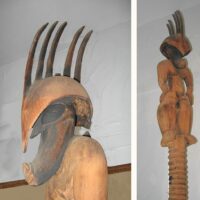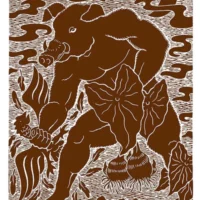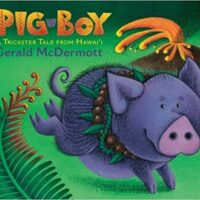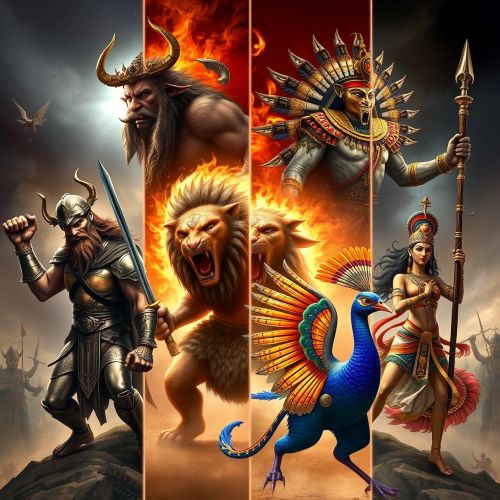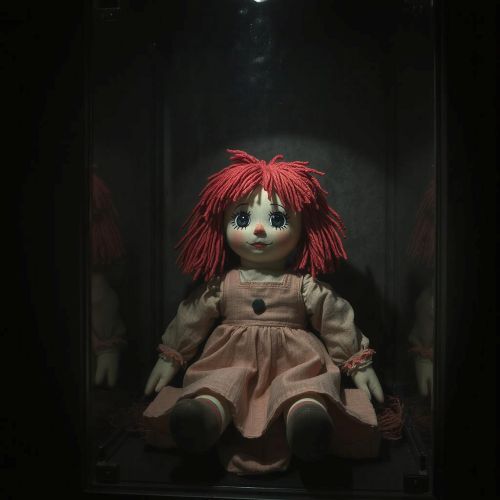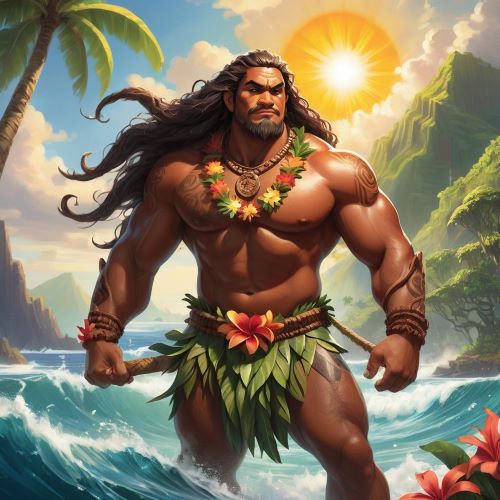Kamapuaʻa : The Hawaiian Man Hog
Listen
At a glance
| Description | |
|---|---|
| Origin | Hawaiian Mythology |
| Classification | Demigods |
| Family Members | Hina (Mother) and Kahikiula (Father) |
| Region | Hawaii |
| Associated With | Fertility, Earth |
Kamapuaʻa
Introduction
Kamapuaʻa, meaning “hog child” in Hawaiian, stands out as one of the most vivid figures in Hawaiian mythology. A shapeshifting demigod, he embodies the tension and harmony between wild nature and cultivated life. Closely associated with Lono, the god of agriculture and fertility, Kamapuaʻa represents rebirth, lush growth, and untamed vitality. His narrative is a dynamic tale of conflict, romance, and transformation—especially seen in his legendary interactions with Pele, the goddess of fire. These stories not only entertain but reflect profound themes about balance in the natural world, where water meets lava, and life emerges from destruction.
Physical Traits
Kamapuaʻa’s appearance shifts as freely as the elements he commands. In his human form, he is described as tall, muscular, and strikingly handsome—often charming and irresistible to those he encounters. But when his wilder instincts rise, he takes the form of a large, bristled hog, complete with tusks and a snout. His duality is emphasized further through kinolau, or “many bodies,” a concept in Hawaiian spirituality where gods manifest in various forms. Kamapuaʻa’s kinolau includes not only the pig but also the kukui tree (symbolizing light), the ʻamaʻu fern, and the reef triggerfish, each linking him to different parts of the environment and underlining his deep connection to both land and sea.
Family
Kamapuaʻa’s lineage places him among high-ranking figures of Hawaiian myth. He was the son of Hina, a goddess linked to the moon, and Kahikiula, a chief of Oʻahu. Raised under the disapproval of his stepfather Olopana, Kamapuaʻa grew up in defiance, setting the stage for his rebellious nature. His grandmother, Kamaunuaniho, played a crucial role in his life, offering guidance and magical support. She is said to have gifted him spells and incantations, empowering his growth as a kupua, or supernatural being. Kamapuaʻa’s familial connections also intertwine with Pele’s lineage—he and Pele bore a child together, creating a symbolic union between water and fire, and linking their descendants to both creation and destruction.
Other names
Kamapuaʻa is most famously known as the “hog child,” but many names and titles are attributed to him, each reflecting a different facet of his power and personality. Among them is “Makawalu,” which translates to “eight eyes.” This name symbolizes not literal vision, but the ability to see beyond appearances—hinting at his shapeshifting skills and perception across realms. In some traditions, Kamapuaʻa is linked to Kane-puaʻa, another god connected with agriculture and boars, underscoring his role in ensuring fertility and rain. Through these various names, Kamapuaʻa is recognized as a protector, a provider, and a challenger of boundaries, often walking the line between chaos and cultivation.
Powers and Abilities
Kamapuaʻa’s powers are as diverse as the ecosystems he represents. At the core is his shapeshifting—he can change into a pig, a fish, a plant, or even mist. These transformations are more than just tricks; they embody his spiritual alignment with nature and his ability to adapt and survive. He commands rain and freshwater streams, which he can call forth to nourish the land or to counteract Pele’s destructive lava flows. In one tale, he leads his forces up the cliffs of Kaliuwaʻa, using clever tactics and supernatural strength to defeat enemies and escape danger.
His connection to fertility isn’t only symbolic. Kamapuaʻa is credited in legend with turning barren landscapes into lush forests, ensuring crops grow and communities flourish. These gifts made him a vital figure for early Hawaiians who relied on agriculture and rain for survival. At the same time, his cleverness and sometimes mischievous spirit reveal him as a trickster who tests social norms and disrupts stagnant power structures.
Modern Day Influence
Kamapuaʻa’s story continues to resonate in modern Hawaiian culture, both as folklore and a symbol of resistance and renewal. His tales are passed down through generations in moʻolelo (oral traditions) and featured in chants, hula, and educational curriculums. Artists like Solomon Enos and others have visually reimagined him in paintings and graphic novels, blending traditional iconography with contemporary narratives that speak to identity, ecological awareness, and cultural pride.
He also features in contemporary cautionary tales—such as the widely known belief that traveling across the Pali Highway with pork in your vehicle can anger the spirits of Kamapuaʻa and Pele, resulting in supernatural consequences. This story reflects a living mythology that continues to influence everyday behavior in the islands.
Kamapuaʻa’s character is also experiencing a renaissance through media—appearing in podcasts, plays, and even as inspiration in role-playing games and comics. His legacy is more than myth; it serves as a framework for understanding human relationships with nature, self-transformation, and cultural identity.
Related Images
Source
Fornander, A. (1916). An account of the Polynesian race: Its origins and migrations. Honolulu.
Schweitzer, V. S. (2023). The legend of Kamapua’a. Coffee Times.
Kakimoto, M. K. (2023, September 25). Megan Kamalei Kakimoto on telling her ancestral tales. The Guardian. https://www.theguardian.com/books/2023/sep/25/our-hawaiian-stories-are-not-meant-to-be-easy-for-you-megan-kamalei-kakimoto-on-telling-her-ancestral-tales
Ulukau: Hawaiian Electronic Library. (n.d.). Kamapuaʻa: The shameless one. https://ulukau.org/ulukau-books/?a=d&d=EBOOK-BECKWIT1.1.235&l=haw
Mindess, H. (n.d.). Humor in Hawaii: Past and present. https://www.mindess.com/hawaiihumor.pdf
Private Tours Hawaii. (2015, July 26). Kamapua’a – The pig god. https://www.privatetourshawaii.com/blog/kamapuaa-the-pig-god
Hawaiʻi State Parks. (2020, October 28). Kamapuaʻa (U.S. National Park Service). https://www.nps.gov/articles/kamapuaa.htm
Frequently Asked Questions
What is lorem Ipsum?
I am text block. Click edit button to change this text. Lorem ipsum dolor sit amet, consectetur adipiscing elit. Ut elit tellus, luctus nec ullamcorper mattis, pulvinar dapibus leo.
What is lorem Ipsum?
I am text block. Click edit button to change this text. Lorem ipsum dolor sit amet, consectetur adipiscing elit. Ut elit tellus, luctus nec ullamcorper mattis, pulvinar dapibus leo.
What is lorem Ipsum?
I am text block. Click edit button to change this text. Lorem ipsum dolor sit amet, consectetur adipiscing elit. Ut elit tellus, luctus nec ullamcorper mattis, pulvinar dapibus leo.
What is lorem Ipsum?
I am text block. Click edit button to change this text. Lorem ipsum dolor sit amet, consectetur adipiscing elit. Ut elit tellus, luctus nec ullamcorper mattis, pulvinar dapibus leo.
What is lorem Ipsum?
I am text block. Click edit button to change this text. Lorem ipsum dolor sit amet, consectetur adipiscing elit. Ut elit tellus, luctus nec ullamcorper mattis, pulvinar dapibus leo.

